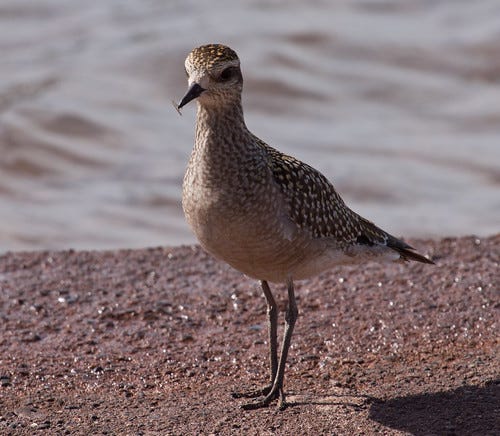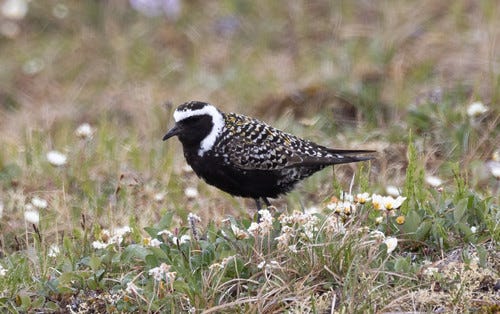(Listen to the radio version here when I record it later today.)
In September 1976, during my first autumn in Madison, Wisconsin, I saw my lifer American Golden-Plover on a Madison Audubon field trip. (Well, until 1998, its official name was the Lesser Golden-Plover.) In May 1977, also on a Madison Audubon field trip, I saw my lifer Peregrine Falcon stooping into a flock of golden plovers. As the birds scattered, the falcon homed in on one, chasing it at high speed, talons outstretched. It just barely missed.

A kid was along on that trip. His junior high biology teacher had assigned his class to each keep a list of birds they saw, and a few days after the field trip, he called me almost in tears because she had accused him of cheating—his list was too long. As proof, she said she knew for a fact that the Peregrine Falcon was extinct.

I called her at the school the next day and explained that she was correct that the nesting population of Peregrine Falcons in the eastern United States had been extirpated (this was in 1977, before Peregrine Falcon reintroduction programs), but a few still migrated through Wisconsin in spring and fall, and many of us experienced birders had seen this one with the boy. She recited a few more “improbable” bird sightings on his list, including our Lesser Golden-Plovers, and I confirmed that he had seen every one of them.

American Golden-Plovers breed up on the tundra of northern Canada and Alaska, but they winter all the way down in southern South America in the pampas of Argentina and the campos of Uruguay. If they flew directly, they’d cover close to 9,000 miles, but the majority of them follow an elliptical migration path: Northbound birds stop and feed along the way as they pass through Central America from January to April, and then gather in great numbers in the mid-continent before their final push north. Most southbound birds take a more easterly route, working their way to the western Atlantic and then flying over the open sea to their wintering grounds, giving them one of the longest known migratory routes.

Understanding the long migration route of golden plovers and seeing my first Peregrine Falcon in hot pursuit of one, the plucky little bird escaping, left me with a powerful impression of what survivors these little birds must be.
But a few years later, I held in my hand tragic proof of their mortality. On September 18, 1991, an Air National Guard F-16 taking off at the Duluth International Airport collided with a flock of birds, and some were sucked into the single engine, causing the plane to crash. (The pilot managed to steer the plane away from houses and then ejected and parachuted to safety.) A week or so later, some aviation investigators came to my house with a mangled wing fragment—dull brown without wing-bars or other obvious markings.
The investigators were hoping to get a quick identification. They’d already brought it up to Hawk Ridge, but no one there wanted to venture a guess, so I was next in line. As a wildlife rehabber, I’d handled a lot of birds, but I didn’t have the specific kinds of references—in particular, a good bander’s handbook—that would have provided wing-chord measurements. But it was fun trying my hand at forensic ornithology, teasing out what clues I could from the evidence at hand. (Too bad I didn’t take any pictures!)
The feathers were too small for a duck but had a duck feather’s subtly plastic-like texture—a kind of waterproofing that meant this was probably a shorebird. The pointed outer primaries were significantly longer than the inner ones, suggesting a long-distance migrant. The lack of markings suggested Solitary Sandpiper or Lesser Golden-Plover, and because it had been killed at the airport, it was more likely to be the one more often found in short-grass fields. I told them my guess was Lesser Golden-Plover.
A couple hours later, they returned with photos of carcasses that had been found on the runway after the crash, and yep—I was right. Like all remains from bird-airplane collisions in the United States, the carcasses were sent to the late Roxie Laybourne, the famous real-life forensic ornithologist at the Smithsonian, for professional confirmation.
Lucky for my credibility, she confirmed my identification, and I was invited into a conference call of aviation experts wondering what the birds were doing in Duluth—according to their information, the birds weren’t supposed to be here in fall.
Although most southbound American Golden-Plovers do indeed head east to the Atlantic Coast rather than south through the inland United States, we’re dealing with functionally illiterate birds who have not read the ornithological research. The eBird range map color-codes the spring and fall records separately, showing that some do take a more inland route.

I don’t get to see American Golden-Plovers often, but most of the times I’ve seen them in Duluth have been in September. I’ve also seen them here, in Ohio, and Wisconsin in May. On my first visit to Costa Rica in January 2001, I saw some that would have been on their northward migration. In 2022, I saw them in their stunning breeding plumage up on the tundra north of Nome.
In the movie The Big Year, Jack Black’s character “Brad Harris” shows a photo of a golden plover to his father, played by Brian Dennehy, and tells him it’s his favorite bird.
That’s your favorite bird? It’s gray.
Yeah. Gray. Well, gray brown. A lot of people wouldn’t think twice to look at this bird, but this golden plover is one of the greatest travelers in the world. It’s true. It breeds in the arctic tundra, then flies all the way down to Argentina and back all in one year. Shows up on beaches in Guatemala, farms in Illinois… Nine inches long, but he travels hundreds of thousands of miles in his lifetime. No passports. No security. Total freedom. Yeah, this great bird has seen some amazing things. That’s the bird everyone underestimates.
My own favorite bird is the Black-capped Chickadee. It’s funny that I would choose such a sedentary bird when I can so appreciate someone else choosing a long-distance migrant specifically for its wandering ways. There are 10,000 species of birds on this planet, and a bazillion reasons why any one of them might be someone’s favorite.










Hoping to see some on Nova Scotia trip this week! Thanks for lovely review of this amazing bird, Laura.
I imagine you’ve seen this video. The range of human responses is interesting in itself. :-)
https://youtu.be/eyqijh2sMao?si=XyKuXmMeBkb9RKO4